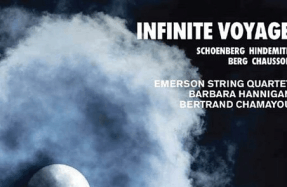
CANADA
L’hiver attend beaucoup de moi/La voix humaine
OPÉRA DE MONTRÉAL
After being postponed twice due to COVID-19, L’hiver attend beaucoup de moi finally had its world premiere online on Nov. 5th.
Opera de Montreal had originally planned to present Laurence Jobidon’s new one-act opera, with a libretto by Pascale St-Onge, in late Mar. 2020. As the pandemic shuttered live performances in Canada, the premiere was postponed indefinitely. In the summer, when cases were down and the situation seemed to be improving, the company set an optimistic new opening night of Oct. 28th. By September, infection numbers in Montreal were soaring again and the Quebec government responded with a second “red zone” lockdown. It looked like Jobidon’s composition might not see a stage at all this year, until OdeM announced that it was moving the performance online. And so L’hiver is finally available (for a limited time) to anyone willing to pay $20 for a link to a pre-taped video.
L’hiver attend beaucoup de moi—the title comes from a line in the libretto—opens with a chord that rings like a whip crack, immediately plunging the audience into the action without a moment’s pause to set the scene. Madeleine (mezzo Florence Bourget) has stopped her old jalopy on an icy track of road in a whirling snowstorm. As if in a trance, she gets out of the car, climbs a snowbank and announces ominously that this is the place. Her passenger Lea (soprano Vanessa Croome) follows her out into the cold, demanding to know why they’re pulled over in the middle of nowhere, miles from the promised safehouse. We see that Lea is young, panicked, and very pregnant. She has purple marks on her face, and it’s obvious they aren’t from the freezing temperatures. Over the next tense 45 minutes, we watch the two women in a battle of wills as past and present traumas collide, and secrets are gradually teased out of the permafrost of memory.
Jobidon’s music swirls in complicated, impressionist patterns, reflecting both the menacing weather and the two women’s turbulent emotions. The score is ambitious, seriously contrapuntal, at times flying off in Baroque melismas. But I found the writing for the soprano unrelentingly high; combined with the rat-a-tat French text, it was unflattering and at times even shrieky for Croome. Jobidon could have better exploited Croome’s warm middle register, or crossed the voices more often for textural interest. Bourget fared better, with most of the music sitting comfortably for her tessitura and showcasing her cool, ashy timbre.
Both singers quarantined before the taping so director Solene Pare would not have to adapt her original staging for physical distancing. Pare’s stage is bare and white save for two snowy hillocks that the women, dressed in bulky, nondescript winter clothing, use as platforms. The text and music are emotive enough, and Pare’s direction emphasizes restrained, natural gestures and expression.
Musical director Jennifer Szeto provided structural clarity, forward impulsion, and assertive, muscular pianism.
L’hiver was always supposed to be produced in a double bill with Poulenc’s one-act solo opera, La voix humaine. OdeM kept to this plan for the online version. The Poulenc comes first in the video, although of course the beauty of a pre-taped show is you don’t have to watch anything in a particular order.
Soprano France Bellemare is riveting as Cocteau’s spurned, desperate Woman. Dressed in silky peach-hued lingerie, with auburn hair pinned in glamorous 1920s finger waves, Bellemare clings to her phone as if it were an oxygen mask. Bellemare’s robust but creamy, luxurious soprano is well suited to this repertoire, although she has a habit of curing off her final Rs, so words like “soir” and “amour” sound like “soi” and “amou”.
Pare was also the director for the Poulenc. She frames Bellemare in a narrow, lit doorway for most of the opera, making the drama feel appropriately claustrophobic—here is a woman on the verge of a breakdown, and the walls are literally closing in on her. For the second half, after the connection is lost for the first time, Pare doesn’t have the protagonist pick up the phone again, so that her account of having tried to kill herself comes across as a shameful, secret confession to nobody, instead of as an honest admission to her lover. The car from L’hiver also makes an appearance in the surprise, cinematic twist Pare has orchestrated for the ending. Esther Gonthier provided a supple, richly nuanced reading of the piano reduction.
—— NATASHA GAUTHIER

As One
ORCHESTRE CLASSIQUE DE MONTRÉAL
Watching the Nov. 20th Quebec premiere of live-streamed on YouTube was a doubly self-conscious experience. Though I have watched many operas on screen before, it was never to review them—never with the magnified focus of having to explain it to someone who was not in the theatre or on my couch. I noticed the camera angles and video effects like a layer of icing on a familiar savory dish: interesting, but mostly something to be scraped off. I suppose it’s the difference between a staged opera transmitted to a screen, and an opera staged specifically for the screen. Cameras often show us what really shouldn’t be seen, like the darting eyes of a singer who has just missed his cue. The main camera angle on first, and heard second.






